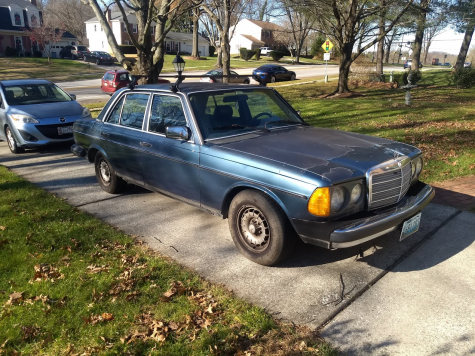What to Know About Buying your First Car

BRAP-BRAP-BRAP-BRAP-BRAP-CLUNK!!! BRAP-BRAP-BRAP-BRAP-BRAP-CLUNK!!!
Ah, the unmistakable sound of a 1980s automatic transmission trying to shift. Specifically, the not-entirely-functional 1980s automatic transmission on my first car, a 1984 Mercedes 300D. It’s kind of an annoying feature of this car, but I love the Mercedes regardless and am willing to put up with this.
However, you–the reader who was nice enough to read my article and put up with my poor imitation of a malfunctioning transmission–might not want to put up with the “quirks” of owning and driving a nearly 40-year old car. That’s why I’m here, to help you figure out what type of first car is right for you. But before we get into that, let’s talk about a few things you should do regardless of what type of car you want:
Do your research
Unless you already know a lot about cars, it is absolutely necessary to learn about them when you are shopping. You don’t have to know everything about all cars, but you should know everything about the makes or models that you are thinking of buying. If you are shopping for a car on a budget, you’re probably going to be looking on Craigslist or Facebook Marketplace, and both sites (especially Craigslist) can be a minefield of scammers.
In addition, you will probably encounter sellers who are well-intentioned but who know nothing about their cars aside from the fact that they have 4 wheels and an engine. So once you’ve decided on a car or a shortlist of a few cars, make sure you know what you should expect to pay for one, what potential areas of unreliability they may have, etc. In addition, you should ask the seller lots of questions about the car’s condition and any issues it may have.
Before buying, do a quick pre-purchase inspection.
Many people recommend getting a mechanic to do a thorough inspection of a used car before you buy it, but this may not be a realistic possibility for people shopping on a budget. However, you should at least do a quick inspection yourself.
Before you go to check out a car, go on the internet to find a list of common problems with the type of car you are buying–whether they rust badly, or are prone to major mechanical problems, etc.
Once you are there in person and ready to buy the car, take a look at the car for these potential problem areas and see if this car has them. Minor, easily repairable issues or surface rust shouldn’t be a deal-breaker, but if a car has severe structural rust or severe mechanical problems, you may want to pass on buying it. And if the seller doesn’t let you do an inspection, they have something to hide and you should go elsewhere.
Mileage is also something to consider when buying a car. If you’re shopping for a car on a budget, most of your options will likely have about 100,000 miles or more. If low mileage is important to you, about 100,000 is a realistic target.
However, while mileage is definitely a factor, the condition of a car is more important. If given the choice between a high-mileage car in great condition and a low-mileage car in poor condition, take the high-mileage car every single time (unless you like doing repairs).
Also, any car–no matter how reliable it might be otherwise–will be unreliable if the previous owner has treated it badly, as this automotive journalist found out
Be realistic about what kind of work you can do yourself.
Before settling on the Mercedes 300D that I own now, I also considered a 1977 Mercedes 280E (a different engine, but the same basic car) that I found on Craigslist for about $800 with a non-functional engine.
I’m now really glad I don’t have that because working on the more minor issues of my 300D has been much more difficult and time-consuming than I anticipated (and the 300D is fairly easy to work on as cars go). If a car needs major work, you should probably avoid it.
One more thing: Just because I don’t mention a car here doesn’t mean it isn’t good. There are several other cars that I would have liked to include, but I didn’t have room for everything. So consider this section to be a starting point, not an extensive resource of every good car.
Some car ideas:
10 to 15-year-old Hondas and Toyotas are always a safe bet. These cars were very popular when new, so they were made in very large numbers and are easy to find today. In addition, they are safe and very well made. The Toyota Corolla and Camry and the Honda Accord and Civic are especially popular choices, but really, it’s hard to think of a modern Honda or Toyota that wouldn’t be a great choice as a used car.
If you want something a little more fun to drive, a Mazda 3 is a great choice. While they might not be as exciting as Mazda’s Miata sports car, they are a lot more practical and are still pretty fun to drive. My family owns a Mazda 5 (basically a minivan version of the Mazda 3 with the same mechanical bits), and it has been extremely reliable, even now that it has nearly 120,000 miles on it. The smaller Mazda 2 is a good choice as well.
A slightly more interesting choice would be the Ford Crown Victoria. This large American sedan is a favorite of taxi companies, police departments, rental fleets, and the like. Once these companies are done with them, they are resold to the general public at very low prices. Because fleet vehicles tend to be very well maintained, they should be in pretty good shape. The Crown Victoria is not the most sophisticated car in the world–for example, its V8 engine is barely more powerful than the 4-or-6 cylinder engines in Hondas or Toyotas and less fuel-efficient. Furthermore, it seems that it isn’t quite as reliable as Hondas or Toyotas. But they’re so easy to find in such good shape for so little money that I would still consider them.
However, you should buy something newer if safety is a high priority. Newer cars tend to have far more advanced safety features and do better in crash tests. For maximum safety, you should buy the newest car with the most safety features you can find within budget.
If you want more details, the Insurance Institute for Highway Safety has compiled a list of safe used cars for teenagers. In my opinion, some of these vehicles are unrealistically expensive for a new driver to afford, but some are only a little over $5K and could potentially be good, affordable choices.
Consumer Reports also has a good list, which factors in safety, road-test performance (how well a car drives), and reliability (based on their reliability survey, which is very reputable).
Notice that there are no large SUVs or trucks on either list. This is because the safety of these vehicles is overrated. While they may provide extra protection in a crash due to their size, their size also makes them harder to drive and they are also more prone to rolling over due to their high center of gravity.
Buy what you like

OK, so you may not be able to buy a Lancia 037 race car as your first car (or ever, unless you win the lottery).
A 10 to 15-year-old Honda or Toyota might be the sensible choice, but not everyone wants that. If the Camry is the car for you, go ahead and buy it. But if you want a huge pickup truck on off-road tires, get a huge pickup truck on off-road tires. If you want a famously unreliable early 2000s Volkswagen, and you’re willing (and able) to put up with the repairs, go ahead and buy one (they’re actually very nice cars when they’re working). If you want a BMW 3-Series, or a 1953 Chevy Bel Air, or a 1984 Mercedes 300D with a partially functional transmission, you should buy one (if you are able to). I’ll get more into that–and what it’s like to own an old car–in another article soon.
Speaking of which, I should go back to work on that. Oh, now the engine won’t turn off. OK, now it will turn off, but the A/C still doesn’t work…
Your donation will support the student journalists of Wilde Lake High School. Your contribution will allow us to purchase equipment and cover our annual website hosting costs.





